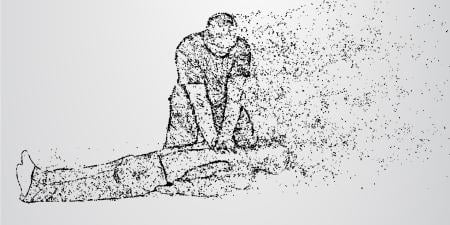Fat embolism is most commonly associated with trauma. Long bone and pelvic fractures are the most frequent causes, followed by orthopedic surgery—particularly total hip arthroplasty—and multiple traumatic injuries. Soft tissue damage and burns can cause fat embolisms, although far less frequently than fracture. The most popular theory about the etiology of fat embolism is that fat globules (emboli) are released by the disruption of fat cells in fractured bone and enter through ruptures in marrow vascular beds. An alternative theory proposes that the emboli result from the aggregation of free fatty acids caused by changes in fatty acid metabolism triggered by trauma or disease. Regardless of the source, increased fatty acid levels have a toxic effect on the capillary-alveolar membrane in the lung and on capillary beds in the cerebral circulation.
Traumatic fat embolism occurs in 90 percent of individuals with severe skeletal injuries, but the clinical presentation is usually mild and goes unrecognized. Approximately 10 percent of these patients develop clinical findings, collectively known as fat embolism syndrome (FES). In its most severe form, FES is associated with a 1-2 percent mortality rate [1]. FES can also occur under several nontraumatic conditions. It can be seen following cardiopulmonary resuscitation, parenteral feeding with lipid infusion, liposuction and pancreatitis. FES has also been proposed as a major cause of the acute chest syndrome in patients with sickle cell disease [2].
Fat embolism syndrome is characterized by pulmonary insufficiency, neurologic symptoms, anemia and thrombocytopenia. The diagnosis is based on clinical presentation of symptoms which usually appear one to three days after injury. Onset is sudden. Presenting symptoms are myriad and include tachypnea, dyspnea and tachycardia. The most significant feature of FES is the potentially severe respiratory effects, which may result in adult respiratory distress syndrome (ARDS). Neurologic symptoms may also be present; initial irritability, confusion and restlessness may progress to delirium or coma. Petechiae appear on the trunk and face and in the axillary folds, conjunctiva and fundi in up to 50 percent of patients and can aid in diagnosis [1-3]. Of these symptoms, respiratory insufficiency, central neurologic impairment and petechial rash are considered major diagnostic criteria, and tachycardia, fever, retinal fat emboli, lipiduria, anemia and thrombocytopenia are considered minor diagnostic criteria [4].
The most effective approach to treatment of FES is prevention. An accepted prevention strategy is early stabilization of fractures, particularly of the tibia and femur, which allows patients to mobilize more quickly. This has been found to decrease the incidence of FES, ARDS and pneumonia and reduce the length of hospital stay [5-7]. Aggressive fluid resuscitation and maintenance of an adequate circulatory volume have also been shown to be protective. More controversial is the use of prophylactic corticosteroids. Nearly all trials of both low and high dose methylprednisolone have demonstrated a reduction in the incidence of FES as well as less severe hypoxemia [8-10]. Since most cases of FES are mild and the great majority of patients recover, concerns regarding the risk of infection and wound healing impairment have limited the routine use of corticosteroids. Once symptoms develop, treatment is supportive. Corticosteroids may be beneficial if cerebral edema is present. Respiratory insufficiency is treated with oxygen therapy and continuous positive end-expiratory pressure ventilation.
References
-
Kumar V, Fausto N, Abbas A. Robbins and Cotran’s Pathologic Basis of Disease. 7th ed. New York, NY: WB Saunders; 2005:137.
-
Meyer NJ, Schmidt GA. Pulmonary embolic disorders: thrombus, air, and fat. In: Hall JB, Schmidt GA, Wood LDH, eds. Principles of Critical Care. 3rd ed. New York, NY: The McGraw-Hill Professional Companies; 2005:366-367.
-
Doherty GM, Mulvihill SJ, Pellegrini CA. Postoperative complications. In: Doherty GM, Way LW. CURRENT Surgical Diagnosis and Treatment. 11th ed. New York, NY: Lange; 2003:27.
-
Liew ASL. Pelvic ring injuries and extremity trauma. In: Hall JB, Schmidt GA, Wood LDH, eds. Principles of Critical Care. 3rd ed. New York, NY: The McGraw-Hill Professional Companies; 2005:1449.
- Bone LB, Johnson KD, Wiegelt J, Scheinberg R. Early versus delayed stabilization of femoral fractures. J Bone Joint Surg Am. 1989;71(3):336-340.
- Johnson KD, Cadambi A, Seibert GB. Incidence of adult respiratory distress syndrome in patients with multiple musculoskeletal injuries: effect of early operative stabilization of fractures. J Trauma. 1985;25(5):375-384.
- Behrman SW, Fabian TC, Kudsk KA, Taylor JC. Improved outcome with femur fractures: early vs. delayed fixation. J Trauma. 1990;30(7):792-797.
- Kallenbach J, Lewis M, Zaltzman M, Feldman C, Orford A, Zwi S. "Low dose" corticosteroid prophylaxis against fat embolism. J Trauma. 1987;27(10):1173-1176.
- Lindeque BG, Schoeman HS, Dommisse GF, Boeyens MC, Vlok AL. Fat embolism and the fat embolism syndrome. A double blind therapeutic study. J Bone Joint Surg Br. 1987;69(1):128-131.
- Schonfeld SA, Ploysongsang Y, DiLisio R, et al. Fat embolism prophylaxis with corticosteroids: a prospective study in high-risk patients. Ann Intern Med. 1983;99(4):438-443.



